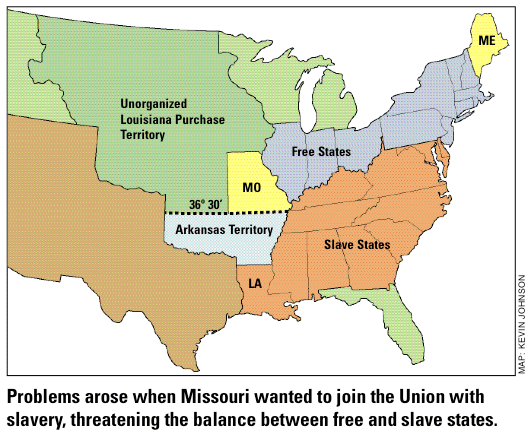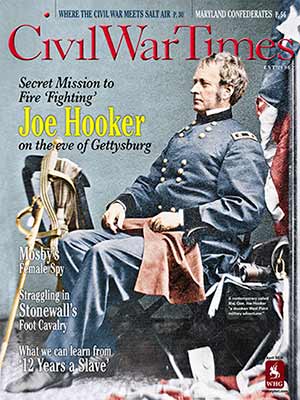Facts, information and articles about Missouri Compromise, one of the causes of the civil war
Missouri Compromise summary: The Missouri Compromise of 1820 was an effort by the U.S. Senate and House of Representatives to maintain a balance of power between the slaveholding states and free states. The slaveholding states feared that if they became outnumbered in Congressional representation that they would lack the power to protect their interests in property and trade.
Missouri Applies For Statehood
In 1819, the slaveholding territory of Missouri applied for admission to the Union. Northern states opposed it, feeling that Southern slaveholding states held too much power already. The Constitution allowed states to count each slave as three-fifths of a person for purposes of determining population, and therefore, the number of Congressional representatives the state was entitled to. This had given the South an advantage in Congress.
Slavery In The Northwest Territory
Slavery had already been creeping into the Northwest Territory (the area between the Ohio River and the Great Lakes), even though the Northwest Ordinance of 1787 prohibited slavery there. Southerners migrating into that region took their slaves with them under the guise of indentured servitude, which was legal in the area. Northerners, most of whom favored “free states” in which slavery was prohibited, feared slavery would become de facto in the states carved from the Northwest Territory. The admission of Missouri, which came from lands obtained through the Louisiana Purchase and lay outside the Old Northwest, added to their fears of the expansion of slavery.
Representative Jame Tallmadge, Jr., of New York offered two amendments to the Missouri statehood bill on Feb. 13, 1819. The first prohibited any further importation of slaves into Missouri; the second required gradual emancipation for the slaves already there. The House passed his amendments, along strictly regional voting lines, but the Senate, where representation of free and slaveholding states were balanced, rejected it.
Congressional debates on the issue raged for a year until the District of Maine, originally part of Massachusetts, sought statehood. Henry Clay of Kentucky, the Speaker of the House, maintained that if Maine were to be admitted, then Missouri should be, too. From this came the notion that states be admitted in pairs, one slave and one free. Senator Jesse B. Thomas of Illinois proposed an amendment allowing slavery below the parallel 36 degrees, 30 minutes in the vast Louisiana Purchase territory, but prohibiting it above that line. That parallel was chosen because it ran approximately along the southern border of Missouri.
The Missouri Compromise Becomes Law
The Missouri Compromise, after much debate, passed the Senate on March 2, 1820, and the House on February 26, 1821.
 Read More in America’s Civil War Magazine
Subscribe online and save nearly 40%!!!
Read More in America’s Civil War Magazine
Subscribe online and save nearly 40%!!!
Though the compromise measure quelled the immediate divisiveness engendered by the Missouri question, it intensified the larger regional conflict between North and South. It served notice to the North that Southerners not only did not intend for slavery to end, they wanted to expand its presence. In the South, the belief grew that Northerners were using slavery as a smokescreen behind which they could resurrect the Federalist Party and strengthen the central government at the expense of states’ rights.
For nearly 30 years, the compromise worked, with two states being admitted together, one slave, one free. Then, in 1850, California was admitted as a stand-alone free state, upsetting the balance 16–15, in exchange for a Congressional guarantee no restrictions on slavery would be placed on the territories of Utah or New Mexico and passage of the Fugitive Slave Act, which required citizens of all states to return any runaway slaves to their masters. In 1857, the U.S. Supreme Court ruled Congress had no right to prohibit slavery in territories, as part of the decision in the Dred Scott case. The Kansas-Nebraska Act of 1854 repealed the 36-30 dividing line for slavery in the Louisiana Purchase area.
Articles Featuring Missouri Compromise From History Net Magazines
Featured Article
Missouri Compromise exposed the raw nerve of slavery
By Parke Pierson

When President Thomas Jefferson purchased 828,000 acres of heartland from Napoleon of France for a little more than $11 million in 1803, he was overjoyed with the prospect of securing the vital Mississippi River and the port of New Orleans for America’s interests. But with all the good that the Louisiana Purchase brought to the United States, it also presented the growing country with a difficult and painful question: Should the states created out of that land be slave or free?
Louisiana had been carved out and accepted as a slave state in 1812, but no other territory had petitioned Congress for statehood out of the purchase lands until Missouri did so in 1818, also wanting to enter the Union as a slave state. That request threatened to unsettle a delicate balance of 11 slave and 11 free states, a balance both sides found necessary for maintaining equal representation in the Senate.
The fledgling abolitionist movement saw a chance to bring its cause to the foreground, and the issue of slavery in Missouri was thrown before the House of Representatives in February 1819 when James Tallmadge of New York proposed an amendment to ban slavery within the boundaries of the new state. Tallmadge also advocated gradual emancipation for the thousands of chattels already living there.
That amendment set off contentious debates within the House and brought the issue of slavery into the national spotlight once again, after the topic had been comparatively quiet since the late 18th century.Southerners adamantly fought the Tallmadge Amendment, protesting the imbalance of representation that having one more free than slave state would cause, as well as the unveiled threat on the institution so critical to the plantation economy.
On the other side of the aisle, most Northern representatives were not abolitionists and cared little for slaves as people, but supported Tallmadge because they believed slavery posed a threat to the farm-and-industry economic model just beginning to take hold above the Mason-Dixon line. In short, they didn’t want large plantations taking all the land from free husbandmen and their families.
In mid-February 1819, the Tallmadge Amendment passed the House by a vote of 82 to 78, but both the slavery ban and the emancipation proposals were defeated in the Senate.
The issue remained at an impasse until December when Maine and Henry Clay, the Speaker of the House from Kentucky who owned slaves but had famously proclaimed that he was an American first and a Southerner second, entered the debate. Maine, up to that time a part of Massachusetts, wanted to enter as a free state, and Clay decreed that could not occur unless Missouri came in with slavery.
In February 1820, Illinois Senator Jesse B.Thomas suggested a proposal that would eventually be called the Missouri Compromise: Maine would enter as a free state, Missouri would come in with slaves, but no slavery would be permitted in other states developed out of the Louisiana Purchase north of 36 degrees 30 minutes latitude, Missouri’s southern boundary. The Thomas proposal was accepted in the Senate but defeated in the House, and ardent debate along sectional lines resumed in Congress.
Clay stepped into the fray again and used his considerable influence and power as House speaker to work with both his Northern and Southern colleagues and have them accept Thomas’ compromise as a resolution to the situation. In early March, Congress finally agreed on what they called the Missouri Compromise.
Many congressmen remained shaken by the controversy. Slavery had once again proved to be an issue that divided the nation along sectional lines. Southerners had been thrown on the defensive to justify their “peculiar institution,” Northerners had fumed that “slave power” was trying to take up all the land, and abolitionists such as Congressman Arthur Livermore of New Hampshire wondered “how long will the desire for wealth render us blind to the sin of holding…our fellow men in chains?”
 Read More in Civil War Times Magazine
Subscribe online and save nearly 40%!!!
Read More in Civil War Times Magazine
Subscribe online and save nearly 40%!!!
he Missouri Compromise would prove to be only a temporary solution to the growing slavery crisis. For 25 years the situation regarding territorial settlement remained relatively calm. But when the Mexican War in 1846-48 brought more land under the United States’ control, the nettlesome issue flared up again. Once more, Henry Clay had to step in to hammer out a compromise—and once more it would be only temporary, as more and more crises over slavery erupted.
As the early debates over Missouri’s admission raged, perhaps no one was more unsettled than the man who had purchased all that cheap land west of the Mississippi River. In 1820 Thomas Jefferson wrote to a friend that the fight over slavery in Missouri “like a fire bell in the night, awakened me and filled me with terror.” Jefferson would die in 1826, but the fire bells over slavery had just begun to toll.
